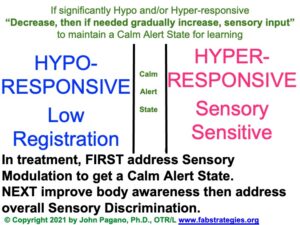Behavioral challenges significantly impact learning and occupational performance in school. Preventing and responding to behavioral problems is an important part of the school occupational therapists’ scope of practice. School occupational therapy practitioners can collaborate with school staff to increase the effectiveness of trauma-informed restraint and seclusion reduction efforts. This involves a 3-tiered approach including environmental adaptations, sensory strategies, and mindful movement breaks embedded in the school schedule (Pagano & Cahill, 2021). A Canadian behavioral school program that included staff training, student problem solving, as well as OT sensory areas and rooms significantly reduced restraint and seclusion (Verret et al., 2019).

The significant relationship found in elementary between sensory processing and behavior problems suggests that both should be addressed in school occupational therapy (Nesayan et al., 2018). Sensory modulation disorder “SMD” reflects unconscious differences in Autonomic Nervous System stress responses that are behaviorally categorized as hyper (over) responsive and/or hypo (under) responsive. Sensory modulation disorder is significantly more common in both youth with Autism Spectrum and Post-Traumatic Stress Disorder (Christensen et al., 2020).

The Integrated transdisciplinary arousal regulation, sensory based, social-emotional and play-based interventions are effective in improving sensory modulation disorder (Christensen et al., 2020). Greatest evidence-based support for treating sensory symptoms to improve developmental and behavioral challenges were found for the Alert Program, Ayes Sensory Integration, Qigong massage, and social stories (Lane, 2020). Recognizing the role of school occupational therapy practitioners in addressing behavioral challenges will help reduce school incidences of restraint and improve the class room environment.
References
Christensen JS, Wild H, Kenzie ES, Wakeland W, Budding D, Lillas C. Diverse autonomic nervous system stress response patterns in childhood sensory modulation. Frontiers in integrative neuroscience. 2020 Feb 18;14:6.
Lane AE. Practitioner Review: Effective management of functional difficulties associated with sensory symptoms in children and adolescents. Journal of Child Psychology and Psychiatry. 2020 Sep;61(9):943-58.
Mills C, Chapparo C, Hinitt J. The impact of an in-class sensory activity schedule on task performance of children with autism and intellectual disability: A pilot study. British Journal of Occupational Therapy. 2016 Sep;79(9):530-9.
Nesayan A, Asadi Gandomani R, Movallali G, Dunn W. The relationship between sensory processing patterns and behavioral patterns in children. Journal of Occupational Therapy, Schools, & Early Intervention. 2018 Apr 3;11(2):124-32.
Pagano J, Cahill S. School OT crisis response & prervention. AOTA Mental Health Toolkit, 2021. https://fabstrategies.org/wp-content/uploads/2022/04/NEWSchool-OT-Crisis-Response-Prevention.pdf
Pingale V, Fletcher T, Candler C. The effects of sensory diets on children’s classroom behaviors. Journal of Occupational Therapy, Schools, & Early Intervention. 2019 Apr 3;12(2):225-38.
Verret C, Massé L, Lagacé-Leblanc J, Delisle G, Doyon J. The impact of a schoolwide de-escalation intervention plan on the use of seclusion and restraint in a special education school. Emotional and behavioural difficulties. 2019 Oct 2;24(4):357-73.
